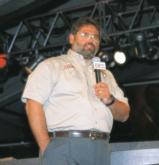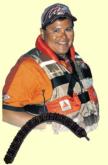Finessing the worm
The centipede – or French fry, as it is sometimes called – is the dullest-looking bait in the business, but it works!
It was my first FLW tournament as a co-angler and I was excited. If the pre-spawn bass in Florida’s Lake Toho were not enough to get me pumped up, then drawing Peter Thliveros as my first-day pro partner was enough to send me into a state of bass tournament bliss.
Thliveros – or Peter T, as he is referred to in fishing circles – has cultivated his professional fishing career on Florida’s bass waters. Lake Toho, not far from his hometown of Jacksonville, happened to be one of the lakes he had fished for many years. Needless to say, I was grinning from ear to ear.
As we drifted around waiting for takeoff, Thliveros was rigging up a few rods for the day’s fishing. He has a reputation for being a Carolina-rig aficionado so it was no surprise to see that the rig was assigned to several of his rods.
 Then, the fellow Floridian pulled out a large bag of what look like lime-green crinkle-cut French fries. “I’ll be throwing a centipede today,” said Thliveros as he threaded the stubby piece of plastic onto a hook. “I’ve got plenty of them if you want some.”
Then, the fellow Floridian pulled out a large bag of what look like lime-green crinkle-cut French fries. “I’ll be throwing a centipede today,” said Thliveros as he threaded the stubby piece of plastic onto a hook. “I’ve got plenty of them if you want some.”
The smile suddenly fell from my face. Was Peter T, the master of the Carolina rig, going to use that worthless stub of plastic? I thought everyone used a lizard on a Carolina rig.
“No thanks,” I said in disbelief.
A few hours later the gregarious pro was balancing a couple of 2-pound bass on a balancing beam. He culled the smaller one and deposited the bigger one into his full livewell, which was right next to my empty live-well.
Then I uttered those dreaded words, “Uh, Pete? Do you think I could get one of those centipedes from you?”
He laughed heartily and then helped me secure my first FLW Tour five-fish limit – on a centipede.
The centipede – or French fry, as it is sometimes called – is the dullest-looking bait in the bass fishing business. In the world of soft plastics, where slender worms and creatures that have legs or tentacles regularly take the spotlight, the centipede might be considered physically impaired. Despite its squab appearance, the lackluster-looking centipede is a jack-of-all-trades.
Carolina-rigging the centipede
Thliveros believes that the muted action of a Carolina-rigged centipede is the very thing that makes fish bite it. “There is something about its deadness that appeals to the fish, especially in cold water, say 50 to 60 degrees,” Thliveros says. Since most water-dwelling creatures are cold-blooded, Thliveros theorizes that the slow, lifeless glide of the centipede is indicative of the way the underwater world behaves at 55-degree temperatures.
Thliveros says that thin, premature vegetation is another premium ingredient for Carolina-rigging a centipede. “I like a centipede on grass lakes like Sam Rayburn or Lake Fork early in the spring, before the grass is real thick,” he notes. “The fish seem to be more receptive to a discreet, unobtrusive bait when the cover is at a minimum.”
According to Thliveros, current also warrants use of the Carolina-rigged centipede. The slim, straight profile makes the bait hydrodynamic and it does not catch as much water. “When the FLW Tour came to Lake Toho the conditions were perfect for Carolina-rigged centipedes,” notes the former Forrest Wood Open winner. “The water was cold, the vegetation was thin and, due to high water, there was a lot of current throughout the whole Kissimmee lakes system.”
Thliveros rigs his Zoom centipede on a 1/0 or 2/0 Gamakatsu EWG hook. He prefers to rig the bait sideways. “Most people thread the centipede on a hook so that the hook sits on the flat underside of the bait. I actually rig the hook in the bait sideways, so that the hook sits in the side of the bait. I have found the bait actually glides better this way,” Thliveros says.
Thliveros uses shorter leaders on his Carolina-rigged centipede in cold water. He does not want bass to move far off the bottom to get the bait, so he stays with 16-to 18-inch leaders.
When selecting tackle for his centipede-studded Carolina rig, Thliveros considers three proven combinations. One is a standard baitcaster matched with a 7-foot rod, 17-pound-test main line, a 3/4-ounce slip sinker, and 17- or 14-pound-test leader. He prefers this setup when probing deep grass or stumps in off-colored water.
Thliveros’ signature Carolina-rig combination is a spinning rod with 12- or 14-pound-test main line, a 1/2-ounce weight, and 10-pound-test Stren High Impact Fluorocarbon leader. This specialty rig is the one that earned Thliveros a top-10 finish and $21,000 at the 2000 Wal-Mart Open on Beaver Lake in Arkansas. “It’s really just a scaled-down Carolina rig that works well with a centipede. The lighter line and fluorocarbon leader are great for clear water and reducing line drag in deep water or current,” he says.
In extreme cases, Thliveros will resort to a mojo rig tipped with a centipede. A spinning rod is necessary for the mojo rig since it is essentially a finesse technique. Thliveros uses 10-pound-test line and a slim mojo sinker in the 1/16-to 1/4-ounce weight category, which he pegs to his line with a piece of rubber. “I resort to this technique when I am targeting shallow-water objects that have had a lot of fishing pressure. I usually use it in five feet of water or less and I throw it to visible items such as laydowns, brush piles, stumps and docks.”
Thliveros prefers natural hues when selecting centipede colors. He keeps watermelon, smoke blue, June bug and grasshopper colored centipedes on board for Carolina rig use.
Centipedes during the spawn
Bass in the spawning cycle can be uncooperative, especially in clear water. Marty Fourkiller of Cherokee, N.C., jazzes up the drab centipede to make finicky spawning bass surrender. Fourkiller brings innovation to the centipede by rigging it wacky style and then inserting a small nail in the head of the bait.
The key to Fourkiller’s wacky centipede rig is a No. 1 or No. 2 Owner Rig-N-Hook and 8-pound-test line. He fishes the setup on a spinning rod. “The critical aspect of this rig is the way it falls through the water,” he says. “The centipede must glide through the water effortlessly. I have found that straight shank hooks and heavier line impede the centipede’s fall. The Owner Rig-N-Hook in a No. 1 size is a very small, compact hook that does not leave a lot of shank sticking out of the worm.”
Fourkiller inserts a small nail into one end of the Zoom centipede. Instead of putting the hook in the middle of the bait, he puts the hook closer to the end with the nail in it. This allows the negligible weight of the nail and the hook to work together in creating a tantalizing fall through the water.
 “The wacky centipede rig works best when fish spawn on underwater objects,” Fourkiller says. “In the clear water lakes of the Midwest, fish will often spawn on a stick, stump, dock piling or rock. Many times these spawning fish have small strike zones that are hard to target with a conventional Texas-rigged plastic. This is where the centipede provides a unique presentation to a fish that is set up on an isolated object.”
“The wacky centipede rig works best when fish spawn on underwater objects,” Fourkiller says. “In the clear water lakes of the Midwest, fish will often spawn on a stick, stump, dock piling or rock. Many times these spawning fish have small strike zones that are hard to target with a conventional Texas-rigged plastic. This is where the centipede provides a unique presentation to a fish that is set up on an isolated object.”
Fourkiller begins his presentation by making a long cast past the nesting fish. Then he will twitch the wacky centipede over the bass, allowing the bait to fall, very slowly, into the fish’s strike zone. The idea is to get the fish to inhale the weightless intruder as it descends past him toward the coveted object the fish is guarding.
The Citgo team member emphasizes that switching colors is part of the technique. He will usually start with subtle colors that mimic minnows such as watermelon, green pumpkin, natural blue or cotton candy. If a fish is particularly stubborn, he will go to outlandish colors in fluorescent tones in hopes of generating a reaction bite from the fish.
“This is a very specialized technique,” Fourkiller admits. “But it is designed for bass that other anglers will pass up because a conventional lure will not stay in a fish’s limited strike zone long enough.”
Powerful finesse
Professional angler George Cochran of Hot Springs, Ark., has broken the centipede from its traditional finesse fishing role by powering up the dainty worm with a flipping stick. It is a technique that he discovered seven years ago while fishing his home lake, Lake Hamilton in Arkansas.
“The boat docks get a lot of fishing pressure on Hamilton,” Cochran explains. “I was looking for an alternative flipping bait, something the fish had not seen. About that same time, the centipede was gaining popularity mostly as a Carolina rig bait. So I rigged one up Texas-style, on a flipping stick, and began pitching it around docks. I was amazed at what I caught, especially behind other anglers.”
As Cochran tinkered with the centipede’s potential as an alternative pitching and flipping bait, he soon discovered that the bait worked best in cold, clear water, especially during the pre-spawn. Like Thliveros, Cochran believes the square worm’s lack of action is the very thing that makes it appealing to bass in cold water. “It just has a straight, lifeless glide to it that looks like a minnow in cold water,” he says.
Cochran rigs his flipping and pitching centipede on 12-pound-test P-line with a small bullet weight and a 1/0 or 2/0 Gamakatsu round bend hook. “It is a merging of the subtleties of finesse fishing and the power of pitching and flipping. It is like finesse flipping,” he says.
In keeping with proper finesse conventions, Cochran is very particular about matching his bullet weight with the centipede. He prefers to use 1/8-ounce weight in shallow water but will go as heavy as 1/4 ounce in deeper water. Matching the centipede’s color with painted bullet weights is an important aspect of Cochran’s finesse flipping rig.
“It is critical to make the centipede look as natural as possible,” Cochran says. “So I will use small hooks and small bullet weights painted in the same color scheme as the centipede to present the bait as a discreet package.”
The Hot Springs angler brings power to his finesse with a 7-foot, 6-inch flipping stick. The flipping stick gives him precise control over presentation, but Cochran cautions anglers against powerful hook sets.
“Small hooks, 12-pound line, and heavy action flipping sticks are not a good combination when setting the hook,” Cochran admits. But, he adds that an angler can compensate with a gentler hook set. “I use more of a sweep set. I reel up the slack and just kind of pull into the fish with a firm but fluid sweep, not a hard, fast motion.”
He aims his powered-up centipede at docks and brush piles most of the time but says the presentation will work around shallow vegetation, too. “The key ingredients are heavy fishing pressure, cold, clear water and shallow cover,” Cochran summarizes.